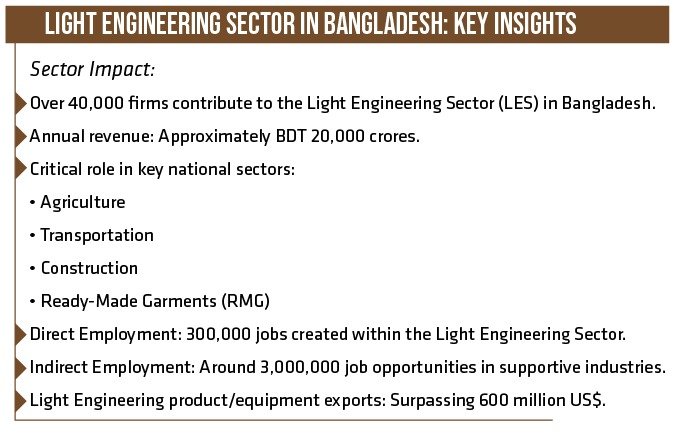The time stretching from 1991 to 2009 is aptly described as the ‘preparation for take-off’’ era for Bangladesh, as the period witnessed the culmination of industrial policies from earlier decades. Since 2010, signifying the initiation of the ‘take-off’ stage, Bangladesh has undergone rapid and impactful changes in its industrial sector. It steadily progressed, advancing from a low-income to a lower-middle-income country, and is now on the brink of graduating from Least Developed Country (LDC) status.

Significant milestones marked the industrial scene in Bangladesh during the 2010s, driven by dynamic trade in the textiles and pharmaceuticals sectors. The notable progress in the leather and light engineering sectors also resulted in unprecedented outcomes. By FY23, the industrial sector’s share of the GDP had risen to 37.6 percent, a substantial increase from 26.54 percent recorded in FY09.
You can also read: Bangladesh’s Strategic Moves: Curbing Imports, Boosting Reserves
The Hongkong and Shanghai Banking Corporation (HSBC) Global forecasts that by 2030, Bangladesh is poised to emerge as the world’s ninth-largest consumer market, surpassing the United Kingdom. This reflects the clear impact of the country’s economic policies in fostering both growth momentum and poverty reduction.

Government’s Move Boosts Leather Industry Transformation
The Government of Bangladesh has identified the leather industry as a pivotal sector due to its labor-intensive nature and increasing global demand, leading to a significant transformation in the first half of FY 2023-2024. Highlighting the importance of the leather industry, the Government of Bangladesh designated leather as a priority sector, declaring the fiscal year 2016-17 as the “Leather Year.”
Some measures have been implemented for the development of this industry. The “Leather Industrial City” – a project implemented on 200 acres of land in Savar for the eco-friendly relocation of tanneries from Hazaribagh in the capital – is now in full production.
Efforts have been initiated to establish export promotion zones and economic zones, aimed at attracting both local and foreign direct investors. Particularly, endeavors have been made to establish leather industrial estates in Chattogram and Rajshahi. Annually, approximately 250 million square feet of raw hides and skins are processed, comprising 63.98% cowhides, 32.74% goat hides, 2.23% buffalo hides, and 1.05% sheep hides.
While China, Vietnam, and India remain major players in the international market, the Bangladeshi leather industry continues to gain a stronger foothold, thanks to its competitive labor costs. Notably, China’s gradual move away from labor-intensive manufacturing towards high-tech and capital-intensive processes is projected to reduce its influence in the global leather products market and expedite the migration of these industries to locations with cost advantages.
A Beacon of Growth in Light Engineering Industry
Bangladesh’s economic development owes much to the pivotal role played by Small and Medium Enterprises (SMEs). These enterprises contribute 20.25% to the country’s GDP, forming a heterogeneous sector that includes both trading and manufacturing activities, with distinctions in employment levels, turnover, and capital investment.
European Union (EU) nations represent a significant market for bicycles, with an annual purchase of approximately 18 million units. Bangladeshi manufacturers are directing their focus towards European exports, particularly to the UK, Germany, Italy, and the Netherlands. Eurostat data reveals that Bangladesh holds the third position among bicycle exporters to the EU and ranks eighth globally.

The sector witnessed a noteworthy year-on-year expansion of 50.4% to $795.63 million in the 2021-22 fiscal year, compared to the $529 million recorded in the 2019-2020 fiscal year. It is worth noting that this period also marked the government’s recognition of light engineering goods as the “Product of the Year.”
Following the announcement, the government opted to establish industrial parks in five districts – Dhaka, Narayanganj, Jashore, Bogura, Gazipur, and Narsingdi. Additionally, there is an ongoing industrial city project led by BSCIC on a 50-acre plot in Munshiganj, with an investment of Tk316 crore.
In the budget for the fiscal year 2022-23, the government introduced a 10-year tax holiday for entrepreneurs specializing in the production of small parts and products essential for factory operations. Furthermore, there are Value Added Tax (VAT) waivers applicable to the manufacturing and commercial distribution of power tillers, along with the supply of locally gathered scrap in the foundry industry.
Redefining Bangladesh’s Pharma Future
Emerging as a major player in the evolving landscape, the pharmaceutical industry is a key contributor to the government’s revenue, ranking second in terms of financial contribution in Bangladesh. The local pharmaceutical industries are now meeting an impressive 97% of the country’s medicinal requirements.
The TRIPS agreement’s patent waiver has empowered pharmaceutical companies in the country to offer medicines at more affordable prices without compromising their financial interests. Furthermore, approximately 43 companies export medications and materials to 92 countries, extending their reach to global markets, including the UK and USA.
An active Pharmaceutical Ingredients (API) industrial park is being established on 200.16 acres of land in Munshiganj dedicated to supplying raw materials for the nation’s promising pharmaceutical industry with an export focus. If the API Park is established, it is anticipated that API costs will see a reduction of approximately 20 percent. In a strategic move, the park will see the establishment of 42 industries, offering a significant boost to the pharmaceutical sector and paving the way for employment opportunities for a workforce exceeding 35,000.
In the tapestry of Bangladesh’s industrial journey, Bangladesh stands at the threshold of global recognition, poised to become the ninth-largest consumer market by 2030. The harmonious blend of government foresight, industry dynamism, and global competitiveness paints a picture of a nation ready to take center stage in the world’s economic arena. As we gaze into the future, the industrial symphony continues, promising not just economic prosperity but also a brighter, more sustainable tomorrow for the nation and its people.


